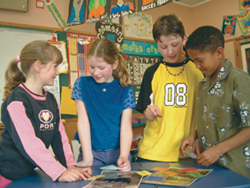![]() SOCIAL DECISION-MAKING: HOW WELL ARE STUDENTS DOING?
SOCIAL DECISION-MAKING: HOW WELL ARE STUDENTS DOING?
![]()
Christine
Harris
| Concern
that social decision-making skills may not develop in sequential
stages for many primary school students sparked interest in exploring
social decision-making data from the 1997 and the 2001 NEMP assessments
of social studies. Social decision-making is about students developing
the necessary skills to address problems they might encounter
in their daily lives. It involves a degree of critical thinking
that needs to be taught to students and not just assumed that
it will occur as part of cognitive development. This study focused
on the ability of Year 4 and Year 8 children participating in
NEMP to perform three skills defined in the New Zealand Social
Studies Curriculum as achievement indicators for social decision-making.
These were identifying a problem/issue, suggesting solutions,
and deciding on the best solution. |
From
the 44 NEMP social studies tasks showing some evidence of social decision-making
skills, four tasks were identified that provided equal opportunity for
the three skills to be evident. The tasks were ‘We Need a Leader’,
‘Tree Troubles’, ‘Saikaloni’, and ‘Playground’.
Videotaped recordings of 200 children (50 per task), randomly selected
from all students tested during 1997 and 2001, as they worked on these
tasks, were then examined. The performances of the Year 4 and Year 8 children
and the performances of the children tested in 1997 and those tested in
2001 were then compared.

| •
Across the two age levels and year spans, the skill the children were
most proficient at was suggesting a possible action or solution, with
70% of students able to do this. Only 40% were able to decide on an
appropriate action. • Overall, the Year 8 students were better than the Year 4 students at the three skills. This was particularly so for the decision-making aspect of the process. |
•
Over the four years, the Year 4 students showed an increase in skill
achievement, while the Year 8 students showed a slight decrease. • The skill achievement of the 2001 Year 4 students was better than that of their 1997 counterparts. The achievement of the 2001 Year 8 students was slightly poorer than that of the 1997 Year 8 students. |
![]()
| •
The results indicate that while social decision-making skills increase
steadily with age and time, deciding a solution is the skill where
students make slowest progress, probably because it requires more
higher order thinking. • There needs to be a stronger focus on decision-making at all levels of the social studies curriculum. • Social studies programmes should provide opportunities for students to work in real situations that are relevant to their environment and their chronological age. For example, an appropriate scenario at Level 1 might be: “What if no one fed the fish in the class aquarium? How can we make sure that the fish are always fed?’ |
•
There is a case for more in-depth as opposed to breadth of coverage
of social studies topics across the five strands. • Micro-teaching should focus on teaching the skills of social decision-making as separate entities. • Teachers’ pre- and in-service programmes should focus on strategies that enable teachers to teach social decision-making skills more effectively. • Teaching children the types of thinking skills that enable them to participate in social decision-making (e.g., how to establish criteria for judging the merits of various solutions to a problem) would provide some skill consolidation and extension in this area. |